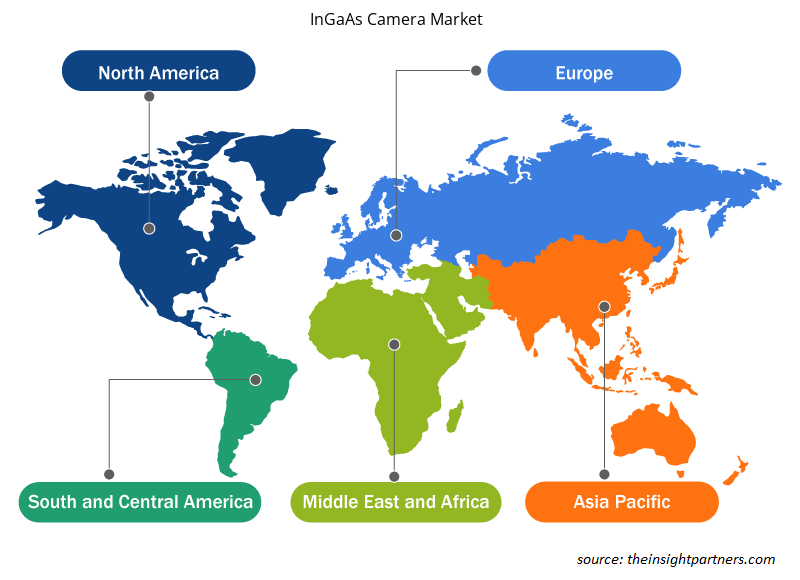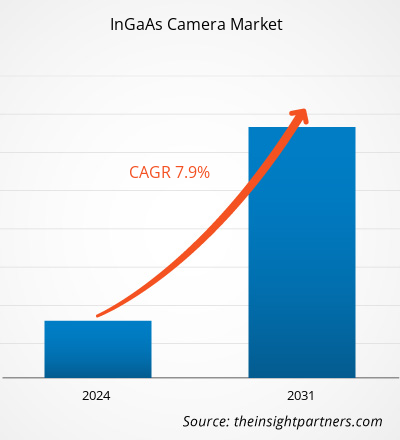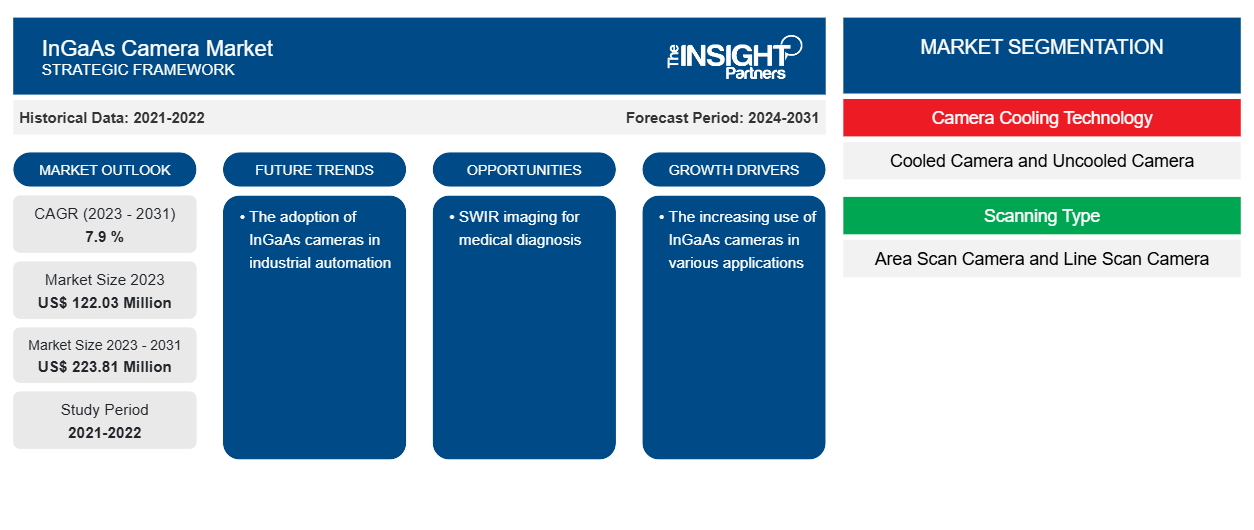InGaAs 카메라 시장 규모는 2023년 1억 2,203만 달러에서 2031년 2억 2,381만 달러로 성장할 것으로 예상됩니다. 이 시장은 2023~2031년 동안 7.9%의 CAGR을 기록할 것으로 예상됩니다. 산업 자동화 분야에서 InGaAs 카메라 채택은 시장의 주요 추세로 남을 가능성이 높습니다.
InGaAs 카메라 시장 분석
InGaAs 카메라 시장 성장은 산업 자동화 및 의료 진단 과 같은 다양한 응용 분야에서 이러한 카메라의 사용 증가에 기인합니다 . SWIR 카메라는 이를 방지하고 원활한 생산 공정을 보장할 수 있습니다. 따라서 다양한 응용 분야에서 InGaAs 카메라 사용을 늘리는 것이 InGaAs 카메라 시장을 주도하고 있습니다. 생물의학 응용 분야를 위한 SWIR 초분광 이미징 및 새로운 양자점(QD) 이미지 센서를 기반으로 하는 광대역(VIS+SWIR) 디지털 홀로그램 현미경 시스템과 같은 SWIR 이미징 기술도 논의됩니다. 따라서 다양한 응용 분야에서 InGaAs 카메라 사용을 늘리는 것이 시장을 주도하고 있습니다.
InGaAs 카메라 시장 개요
InGaAs 센서는 물리 및 생명 과학에서 관련성을 위해 사용되며 단파 적외선(SWIR)으로 알려진 900-1700nm 파장 범위에서 높은 감도가 필요합니다. 일부 InGaAs 센서는 재료 구성의 변화로 인해 최대 2500nm까지 측정할 수 있습니다. 실리콘 기반 CCD 카메라는 UV-NIR 범위에서 감도를 가지고 있지만 실리콘의 밴드갭 특성으로 인해 이러한 CCD는 1100nm에서 충분한 감도를 갖지 못합니다. InGaAs 카메라는 밴드갭이 낮아 단파 적외선(SWIR) 영역에서 응용 프로그램에 선호되는 재료입니다.
귀하의 요구 사항에 맞게 이 보고서를 사용자 정의하세요
이 보고서의 일부 또는 국가 수준 분석, Excel 데이터 팩을 포함하여 모든 보고서에 대한 사용자 정의를 무료로 받을 수 있으며 신생 기업 및 대학을 위한 훌륭한 혜택과 할인 혜택을 이용할 수 있습니다.
-
이 보고서의 주요 시장 동향을 알아보세요.이 무료 샘플에는 시장 동향부터 추정 및 예측까지 다양한 데이터 분석이 포함됩니다.
InGaAs 카메라 시장 동인 및 기회
다양한 응용 분야에서 InGaAs 카메라 사용 증가
실리콘 결정체와 잉곳(벽돌이라고도 함)을 검사하는 것은 반도체 분야에서 InGaAs 카메라에 가장 인기 있는 응용 분야 중 하나입니다. 1,150nm 이상의 파장 범위에서 실리콘을 볼 수 있는 능력은 InGaAs 카메라에 결정체나 잉곳 내의 불순물과 같은 내포물을 감지하는 데 적합한 솔루션을 제공하며, 이는 생산 공정 중에 모일 수 있습니다. 불순물은 다이아몬드 체인으로 잉곳을 얇은 웨이퍼로 관찰할 때 중요합니다. 체인이 작은 금속 조각과 같은 요소에 부딪히면 매우 비싼 체인이 끊어질 수 있습니다. 체인을 교체하면 비용이 발생할 뿐만 아니라 생산성이 낮아지고 수익이 감소합니다. SWIR 카메라는 이를 방지하여 원활한 생산 공정을 보장할 수 있습니다. 따라서 다양한 응용 분야에서 InGaAs 카메라 사용을 늘리는 것이 InGaAs 카메라 시장을 주도하고 있습니다.
의료 진단을 위한 SWIR 이미징
SWIR 이미징은 의학적 진단에 사용됩니다. SWIR 광을 기반으로 하는 개발 기술에는 광열제 및 발광 나노온도계로서 SWIR 나노입자의 제작 및 사용, 희토류 도핑 나노입자(REDN)의 구조, 설계 및 SWIR 관련 생물의학적 응용 분야의 최근 발전이 포함됩니다. REDN은 가장 높은 광도와 생체적합성을 가진 SWIR 방출기 중 하나입니다. 생물의학적 응용 분야를 위한 SWIR 초분광 이미징 및 새로운 양자점(QD) 이미지 센서를 기반으로 하는 광대역(VIS+SWIR) 디지털 홀로그램 현미경 시스템과 같은 SWIR 이미징 기술도 논의됩니다. 따라서 다양한 응용 분야에서 InGaAs 카메라 사용을 늘리는 것이 시장을 주도하고 있습니다.
InGaAs 카메라 시장 보고서 세분화 분석
InGaAs 카메라 시장 분석에 기여한 주요 부문은 카메라 냉각 기술, 스캐닝 유형, 응용 분야입니다.
- 카메라 냉각 기술을 기반으로 InGaAs 카메라 시장은 냉각 카메라와 비냉각 카메라로 나뉩니다. 소프트웨어 세그먼트는 2023년에 더 큰 시장 점유율을 차지했습니다.
- 스캐닝 유형을 기준으로 시장은 영역 스캔 카메라와 라인 스캔 카메라로 구분됩니다.
- 시장은 응용 분야별로 군사 및 방위, 산업 자동화, 과학 연구로 구분됩니다.
지역별 InGaAs 카메라 시장 점유율 분석
InGaAs 카메라 시장 보고서의 지리적 범위는 주로 북미, 아시아 태평양, 유럽, 중동 및 아프리카, 남미 및 중부 아메리카의 5개 지역으로 나뉩니다.
APAC는 InGaAs 카메라 시장을 지배합니다. 산업 자동화 도입에 대한 수요 증가, 비파괴 검사, 머신 비전 애플리케이션 도입 증가는 예측 기간 동안 InGaAs 카메라 시장 성장을 견인할 것으로 예상됩니다.
InGaAs 카메라 시장 지역 통찰력
Insight Partners의 분석가들은 예측 기간 동안 InGaAs 카메라 시장에 영향을 미치는 지역적 추세와 요인을 철저히 설명했습니다. 이 섹션에서는 북미, 유럽, 아시아 태평양, 중동 및 아프리카, 남미 및 중미의 InGaAs 카메라 시장 세그먼트와 지리에 대해서도 설명합니다.

- InGaAs 카메라 시장에 대한 지역별 특정 데이터 얻기
InGaAs 카메라 시장 보고서 범위
| 보고서 속성 | 세부 |
|---|---|
| 2023년 시장 규모 | 1억 2,203만 달러 |
| 2031년까지 시장 규모 | 2억 2,381만 달러 |
| 글로벌 CAGR (2023-2031) | 7.9% |
| 역사적 데이터 | 2021-2022 |
| 예측 기간 | 2024-2031 |
| 다루는 세그먼트 |
카메라 냉각 기술로
|
| 포함된 지역 및 국가 |
북아메리카
|
| 시장 선도 기업 및 주요 회사 프로필 |
|
시장 참여자 밀도: 비즈니스 역학에 미치는 영향 이해
InGaAs 카메라 시장은 소비자 선호도의 변화, 기술 발전, 제품의 이점에 대한 인식 증가와 같은 요인으로 인해 최종 사용자 수요가 증가함에 따라 빠르게 성장하고 있습니다. 수요가 증가함에 따라 기업은 제품을 확장하고, 소비자의 요구를 충족하기 위해 혁신하고, 새로운 트렌드를 활용하여 시장 성장을 더욱 촉진하고 있습니다.
시장 참여자 밀도는 특정 시장이나 산업 내에서 운영되는 회사나 기업의 분포를 말합니다. 주어진 시장 공간에 얼마나 많은 경쟁자(시장 참여자)가 존재하는지 그 규모나 전체 시장 가치에 비해 나타냅니다.
InGaAs 카메라 시장에서 활동하는 주요 회사는 다음과 같습니다.
- 하마마츠 포토닉스 주식회사
- Allied Vision Technologies GmbH
- 새로운 이미징 기술
- 펨브로크 인스트루먼트 LLC
- 폴리텍 GmbH
- 랩터 포토닉스 리미티드
면책 조항 : 위에 나열된 회사는 어떤 특별한 순서에 따라 순위가 매겨지지 않았습니다.

- InGaAs 카메라 시장의 주요 기업 개요를 알아보세요
InGaAs 카메라 시장 뉴스 및 최근 개발
InGaAs 카메라 시장은 1차 및 2차 조사 이후의 정성적, 정량적 데이터를 수집하여 평가합니다. 여기에는 중요한 기업 간행물, 협회 데이터 및 데이터베이스가 포함됩니다. InGaAs 카메라 시장의 몇 가지 개발 사항은 다음과 같습니다.
- 최첨단 광자 기술과 제품의 선도적 공급업체인 하마마츠 포토닉스는 400nm에서 1700nm의 가시광선에서 근적외선 영역에 대한 감도를 가진 새로운 InGaAs 카메라를 출시했습니다. (출처: 하마마츠 포토닉스, 보도자료, 2024년 2월)
- 일본 BlueVision Ltd.는 2021년 4월에 완전히 새로운 1K InGaAs 센서인 BV-C3110이라는 새로운 1K SWIR 라인 스캔 카메라를 출시했습니다(출처: BlueVision Ltd, 보도자료, 2021년 4월)
InGaAs 카메라 시장 보고서 범위 및 제공물
“InGaAs 카메라 시장 규모 및 예측(2021-2031)” 보고서는 아래 영역을 포괄하는 시장에 대한 자세한 분석을 제공합니다.
- 범위에 포함된 모든 주요 시장 세그먼트에 대한 글로벌, 지역 및 국가 수준의 InGaAs 카메라 시장 규모 및 예측
- InGaAs 카메라 시장 동향 및 드라이버, 제약, 주요 기회와 같은 시장 역학
- 자세한 PEST/포터의 5가지 힘과 SWOT 분석
- 주요 시장 동향, 글로벌 및 지역 프레임워크, 주요 업체, 규정 및 최근 시장 개발 사항을 포괄하는 InGaAs 카메라 시장 분석
- 시장 집중도, 히트맵 분석, 유명 업체 및 InGaAs 카메라 시장의 최근 개발 사항을 다루는 산업 환경 및 경쟁 분석
- 자세한 회사 프로필
- 과거 분석(2년), 기준 연도, CAGR을 포함한 예측(7년)
- PEST 및 SWOT 분석
- 시장 규모 가치/거래량 - 글로벌, 지역, 국가
- 산업 및 경쟁 환경
- Excel 데이터세트
최근 보고서
관련 보고서
사용 후기
구매 이유
- 정보에 기반한 의사 결정
- 시장 역학 이해
- 경쟁 분석
- 고객 인사이트
- 시장 예측
- 위험 완화
- 전략 기획
- 투자 타당성 분석
- 신흥 시장 파악
- 마케팅 전략 강화
- 운영 효율성 향상
- 규제 동향에 발맞춰 대응























 무료 샘플 받기 - InGaAs 카메라 시장
무료 샘플 받기 - InGaAs 카메라 시장